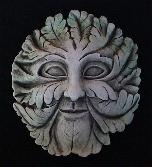
Home | Product Categories | About
Historic Impressions | How to contact
us | FAQ |
STORE
The green man, symbol of oneness with the earth, can be
found in corners and crevices of cathedrals throughout Europe. This
classic example, c. 1240, is from Le Mans Cathedral in France.
6" x 5.5"
brown/green, grey/green
Animal heads like this 11th century carving can
be found throughout Ireland and England and display the powerful
artistic contribution of the Viking culture to these countries.
The animal depicted is most likely a wolf, now vanished from
these regions, but at one time an important animal in
Celtic-Norse iconography.
7.75" x 5"
greystone
These Classical Greek lovers were immortalized
here by the Pre-Raphaelite artist, Edward Burne-Jones for the
1896 edition of the Kelmscott Chaucer. Shakespeare also wrote a
play about them as did Bocaccio. The work was published by
William Morris, himself a noted designer of the time. The style
and subject matter, like all work done by the Pre-Raphaelites,
rejects the modern age and all it stands for and looks back with
nostalgia to medieval times which were viewed as a purer age with
people more honorable and objects and surroundings untouched by
the ugliness of mechanization and industrialization.
6.75" x 5.25"
brown/green, blue/green
These merrily frolicking women are from a Burne-Jones engraving
in the Kelmscott Chaucer and part of the Romance of the Rose
tale, a most popular novel in medieval times. The Kelmscott
Chaucer was published by the famous designer William Morris.
7" x 5.5"
brown/rose/green, blue/mauve/green
This endearing little scene is taken from an engraving in a
medieval French manuscript and depicts a peaceful meeting of
animals under the stars including unicorn, stag and dog.
6" x 2.5"
antique brown, blue
Showing a hunter with his dogs and a stag, this
10th century cross is found in Middleton Church in the North
Riding Forest of Yorkshire, England, where marauding Vikings
reigned in the early medieval period. Although probably intended
as a Christian statement, the style adopted, a wheel cross atop a
shaft, echoes the symbol for the pagan Norse deity, Odin, which
was a cross inside a circle. The stories of Christ and Odin were
indeed similar and the two figures were sometimes used
interchangeably. The hunter and stag can be seen as a metaphor
for the Christian soul (the hunter) attempting to capture the
stag (Christ).
9.25" x 3.25"
greystone
This French Gothic gargoyle, a legendary
guardian against evil, is also partially transformed into
vegetation like the Green Man, a symbol of oneness with the
earth. It is carved on the Palais de Justice in Beauvais, France.
Shape-shifting images like this also allude to the continuity and
sameness of all life.
6" x 5.5"
greystone
This ancient design, known for thousands of
years as a mystical symbol of the "maze of life" in
many world cultures, was carved at an ancient Celtic site near
Tintagel Castle in Cornwall, connected to Arthurian legend. The
labyrinth itself, once dated to the Bronze Age, is now believed
to have been carved somewhere from the 5th through the 17th
century. There were Celtic settlements in the area who may have
carved it in the earlier centuries, and in later centuries
practitioners of ancient earth religions who are known to have
used labyrinths in childbearing and for meditation.
9.5" x 8"
greystone
A portion of a 12th century stone carving
showing Christ holding the host and making the sign of peace. One
of the apostles, St. John, the beloved of Christ, is depicted to
the right.
5.5" x 4.5"
greystone
This tree is the centerpiece of the magnificent door of Kilpeck
Church, England, which combines Celtic and Norse imagery. The Tree
of Life (which later became the Celtic cross itself) was a vertical
path to heaven rooted here on earth. The Norse Tree of Life,
Yggdrasil, had three roots as does this one. The Kilpeck tree also
bears fruit, a symbol of nourishment. Hanging from it are two
lotus blossoms, an Eastern symbol of spiritual enlightenment often
pictured with Buddha. Thus all who entered through this portal
were promised a bridge to heaven, nourishment for the soul and
enlightenment of the spirit.
10.75" x 6.5"
colorized sandstone
Odin (Wodan) was the chief god of Viking-Teutonic warriors. He
gained supreme enlightenment by giving up an eye; and his breath,
shown here as the wind, was the breath of life. This 16th century
carving is from Austria.
7.5" x 4"
greystone
This motif, a form of the ancient Celtic
symbol for renewal and immortality, is taken from the 15th
century MacMillan's Cross, located at Kilmory in Knapdale,
Scotland near the banks of Loch Sween. The more usual
manifestation of this symbol is the snake biting its tail. The
cross is considered one the finest examples of West Highland
sculpture and was dedicated to Alexander MacMillan, the chief of
the clan. The dog depicted here is probably a wolfhound, used by
nobles for hunting and companionship. The dog was itself a symbol
of nobility as it was illegal for the common man to own certain
types of dogs.
4.75" x 4.5"
greystone
Possibly the most famous pig in Scotland, this porcine bagpipe-
player is from a 15th century reconstruction of Melrose Abbey,
where the heart of Robert the Bruce is said to be buried.
7.75" x 4"
sandstone
Home | Product Categories | About
Historic Impressions | How to contact
us | FAQ |
STORE
Copyright © Historic Impressions.
All rights reserved.
No part of this document or of any of our work may be reproduced
in any form,
photographic, mechanical or otherwise, without written permission
from Historic Impressions.